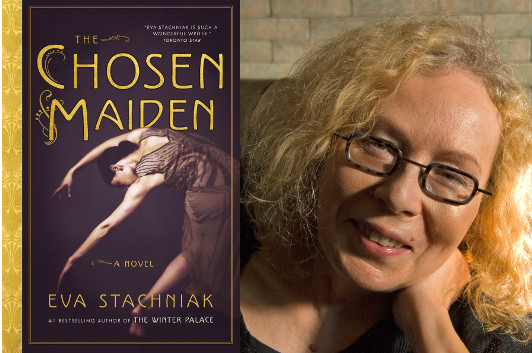Eva Stachniak’s Fierce Power of Women

photo: StanisÅ‚aw Jerzmański
Eva Stachniak has written several novels, including The Winter Palace and Empress of the Night. Her latest, The Chosen Maiden, has just come out, and it vividly recreates the early life of Bronislava Nijinska, one of the great dancers of the 20th century. (You may have heard of her older brother, Vaslav Nijinsky.) In this essay, Stachniak explains what prompted her to take up Nijinska’s story… and how it ended up being a more personal story than she’d expected.
Having written two novels inspired by Catherine the Great, I wished to explore the time when Catherine’s legacy was coming to its violent end. This time it was not the Imperial court itself that attracted me, however, but the Artists of the Imperial Theatres, the stars of the Russian ballet. One of them was Bronislava (Bronia) Nijinska, a brilliant dancer and choreographer who came of age just as the Imperial Ballet, once an obedient and obliging child of the court, broke into open revolt and began to assert its own vision of what Russian art should become.
What drew me to Bronia? There was, of course, the tantalizing connection to her beloved elder brother, Vaslav, the God of the Dance (he was her mentor but she was the best interpreter of his choreography). There was the Polish connection (both Nijinsky parents came to Russia from Poland and Polish was Bronia’s mother tongue). There were her choreographic visions forged in the cauldron of revolutionary Russian art which secured her a firm place in the history of modern dance. But, in the end, as I pored over the treasures of the Bronislava Nijinska archives at the Library of Congress—boxes of intimate diaries, letters, and snapshots she took of her family and friends—the two main themes of The Chosen Maiden began to emerge: art as the source of inner strength and the steadfast solidarity of the Nijinsky women.
13 February 2017 | guest authors |
Courtney Elizabeth Mauk’s Characters Are Stronger Together

photo: Jiyang Chen
Courtney Elizabeth Mauk‘s new novel, The Special Power of Restoring Lost Things, introduces us to a family in pain: a mother, father, and son all struggling to cope with the disappearance of their daughter (older sister) Jennifer nearly a year ago. Rapidly moving from one perspective to the next within the story’s tight time frame, Mauk shows us how the three survivors are pushing themselves away from each other—recognizing that that’s what they’re doing but at the same time unable (or perhaps unwilling) to make the necessary course corrections. Here, Mauk explains how a novel about a family grew out of a short story about a mother… and how she was able to manage the sudden shift in scale.
One value I most want to instill in my son is empathy. I hope he grows into a man capable of looking at the world from perspectives not his own, that he develops the capacity to feel the full spectrum of emotions, strives for understanding, and acts with compassion. These are also the reasons why I write. I wouldn’t always have been able to define my writing this way, as an act of empathy, or an attempt to move the world, in some small way, in a more empathetic direction. I would have talked about the storytelling compulsion, a love of words that started in childhood, an urge to create something lasting. And all these things are true too. But at the heart of the matter is feeling. I write because I want to open up human experience, for myself as well as my readers.
This has never been more the case than in The Special Power of Restoring Lost Things. The book began as a short story about the mother of a young woman who has gone missing. I’ve long had a fascination with the missing; it seems confounding that a person can be here and then gone, leaving few traces, especially in this traceable age. I am intrigued by the mystery of the disappeared but even more so by those left behind, grappling for answers in a suddenly altered world. A pivotal scene in the story (which didn’t make the cut to the book) has the mother riding the Staten Island Ferry over and over, held in a literal stasis. I had a vision of her dragging this heavy weight—an indescribable grief with nowhere to land.
22 November 2016 | guest authors |

 Our Endless and Proper Work is my new book with Belt Publishing about starting (and sticking to) a productive writing practice.
Our Endless and Proper Work is my new book with Belt Publishing about starting (and sticking to) a productive writing practice. 
